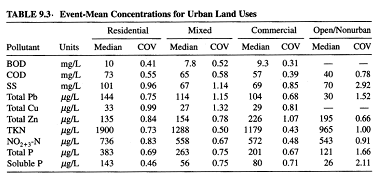Reference no: EM13375753
1. A watershed contains 16.2 ha and 24.3 ha of agricultural and residential land use, respectively. The last rainfall removed all P accumulations and was followed by a 2 day dry period before a 12.7mm rain event with duration = 60 min., P loading rate for agricultural land use = 1,656 g/day, P loading rate for residential land use = 1.8 kg/ha/yr, determine:
(i) the initial P load in grams.
(ii) the average P concentration in the runoff if the overall (agricultural and residential areas) runoff coefficient = 0.4, 40% of P is removed from the agricultural area by rainfall, and 90% of P is removed from the residential area by rainfall.
(iii) the concentration of P (mg/L) after the first 10 minutes of runoff assuming that the amount washed off from the residential and agricultural areas follows a first order reaction:
P0 -Pt = P0 (1 - e-kRt)
where Po is the initial loading (kg), Pt is the mass remaining after time t, k = 0.181 mm-1 and R (mm/hr) is the rainfall excess. Assume that the volume runoff after 10 min is 0.4 x 106 L.
2. The direct runoff measured for a storm event for a catchment, with an impervious area of 500 ha is provided in the table below. Given that the rate of change of solids remaining is proportional to the solids remaining, or dP/dt = kP where P (kg) is the weight of solids, t (hr) is time and k = 2 cm-1 and the initial mass Po = 2,000 kg, derive the pollutograph and the loadograph.
3. An urban residential area is estimated to have I = 40%, average annual rainfall of 1,320mm and it is estimated that 50% of rainfall does not produce runoff. Using the EMC listed in Table 9.3, estimate the median and 90th percentile load of SS contained μ + 1.28sd.min the runoff. Note: COV = coefficient of variance (= sd/mean), x90 = μ + 1.28sd.
